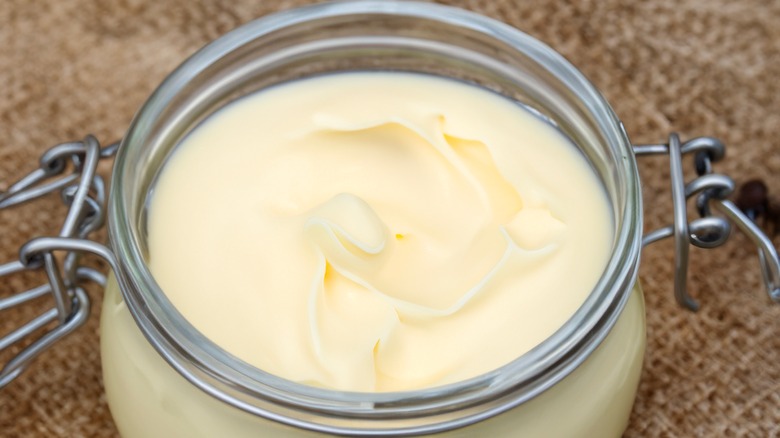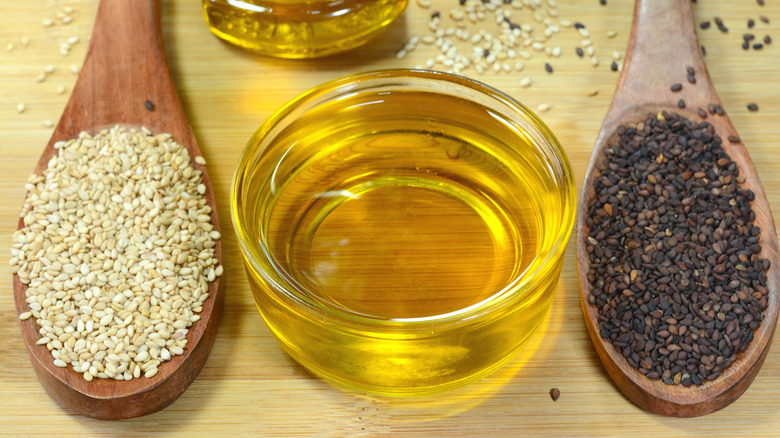What's The Difference Between Beef Tallow And Seed Oil?
Cooking with oils and fats is a common practice that's been used to add flavor and properly heat foods for ages. Despite losing traction in the late 20th century, beef tallow has been slowly making a comeback in both the food and health worlds. But for all the talk about it, not everyone knows what beef tallow is or how to cook with it — much less how it compares to common seed oils. To understand more about the difference between the two we spoke to Dennis Littley, chef and recipe expert at Ask Chef Dennis, in an exclusive Food Republic interview.
Beef tallow, also known as 'beef drippings', is made by simmering and breaking down the fat that surrounds a cow's organs. It was typically used for deep frying, given its ability to perform well under high heat, until it was replaced by seed oils. As the name implies, seed oils are extracted from the seeds of vegetables, which give you products like canola and sunflower oil. Compared to beef tallow, seed oils were deemed to have more nutritional value, which is why many establishments and households made the switch. However, gaining a better understanding of the functions, textures, and flavors of both cooking options will not only improve your recipes, but provides you with factual nutritional information, as well. Thankfully, Chef Dennis is an expert in all things tallow and oil, and shared much insight into the realities of cooking with both types of fat.
What is beef tallow?
Simply put, beef tallow is the fat rendered from, you guessed it, beef. Often referred to as 'liquid gold', beef tallow is known for having a lot of fat-soluble vitamins, along with fatty acids that can be good for gut health in small doses. Where beef tallow really shines is during the cooking process, especially when using high-heat methods. "Compared to seed oils like canola or soybean, beef tallow is more stable under heat, has zero trans fats, and isn't as heavily processed," chef Dennis Littley shared. Beef tallow's smoking point comes in at a high 400 degrees Fahrenheit — this temperature is ideal for frying, roasting, and even seasoning cast iron pans with your beef tallow.
The important question remains: How does beef tallow affect flavor? Well, it isn't called liquid gold for nothing. "Flavor-wise, tallow has personality," Littley told Food Republic. "It's not for every dish, but when you want real character in your cooking, it brings something special that neutral oils just can't match." Beef tallow's natural umami quality and savory undertones make it great for bringing out that same richness in other foods, all while adding a smokiness at top temperatures. If you want to try cooking with beef tallow at home, deep frying a potato product is a good place to start — you will get a taste for how the tallow interacts with the starch to create the ultimate crispy bite. After all, there's a delicious reason fast food chains used beef tallow to cook fries for so many years.
What are seed oils?
Seed oils don't just refer to those seemingly fancy alternatives — in fact, one of the most common pantry staples also fits this classification. That's right, vegetable oil actually comes primarily from seeds, and contains a good amount of Omega-6 fatty acids, hence why it's so popular. This is where the debate tends to start within the culinary and nutrition worlds, because both beef tallow and seed oils contain similar fat properties, and are both said to provide both health benefits and drawbacks. According to Dennis Littley, "Seed oils often go through chemical refinement, bleaching, and deodorizing, while good-quality tallow is usually just rendered fat, nothing extra." However, seed oils come in much larger varieties, and are a great solution for those who cut out meat from their diets.
In truth, it comes down to a matter of preference — certain seed oils will emulate the flavor of the fruit or nut they come from, while also being a lighter alternative to the richness of beef tallow. On the other hand, beef tallow can provide a depth of flavor and texture that you can't achieve using seed oils, and it is more naturally sourced. As debate continues, it's best to investigate which of these fatty acids best suit your dietary preferences, and how each cooking fat will impact your recipes. With each of these ingredients having many good qualities, it's worth experimenting and exploring the difference between seed oils and beef tallow for yourself.



